Principles of Wound Management: Comprehensive Analysis and Review
VerifiedAdded on 2023/05/26
|6
|1163
|201
Homework Assignment
AI Summary
This assignment provides a comprehensive overview of wound management principles, focusing on the observation and documentation of healing progress, evaluation of wound management strategies, and assessment of dressing product effectiveness. It covers the treatment types for various ulcers, characteristics of pressure injury stages, and principal causes of pressure injuries. Intrinsic factors leading to pressure injuries and the assessment and dressing of skin tears are also discussed. Furthermore, the assignment addresses the management of skin graft oozing and highlights the importance of interdisciplinary approaches to wound care. The role of wound drainage in healing is also emphasized, making this a thorough guide to wound management in healthcare. This student assignment is available on Desklib, where students can find more solved assignments and past papers.
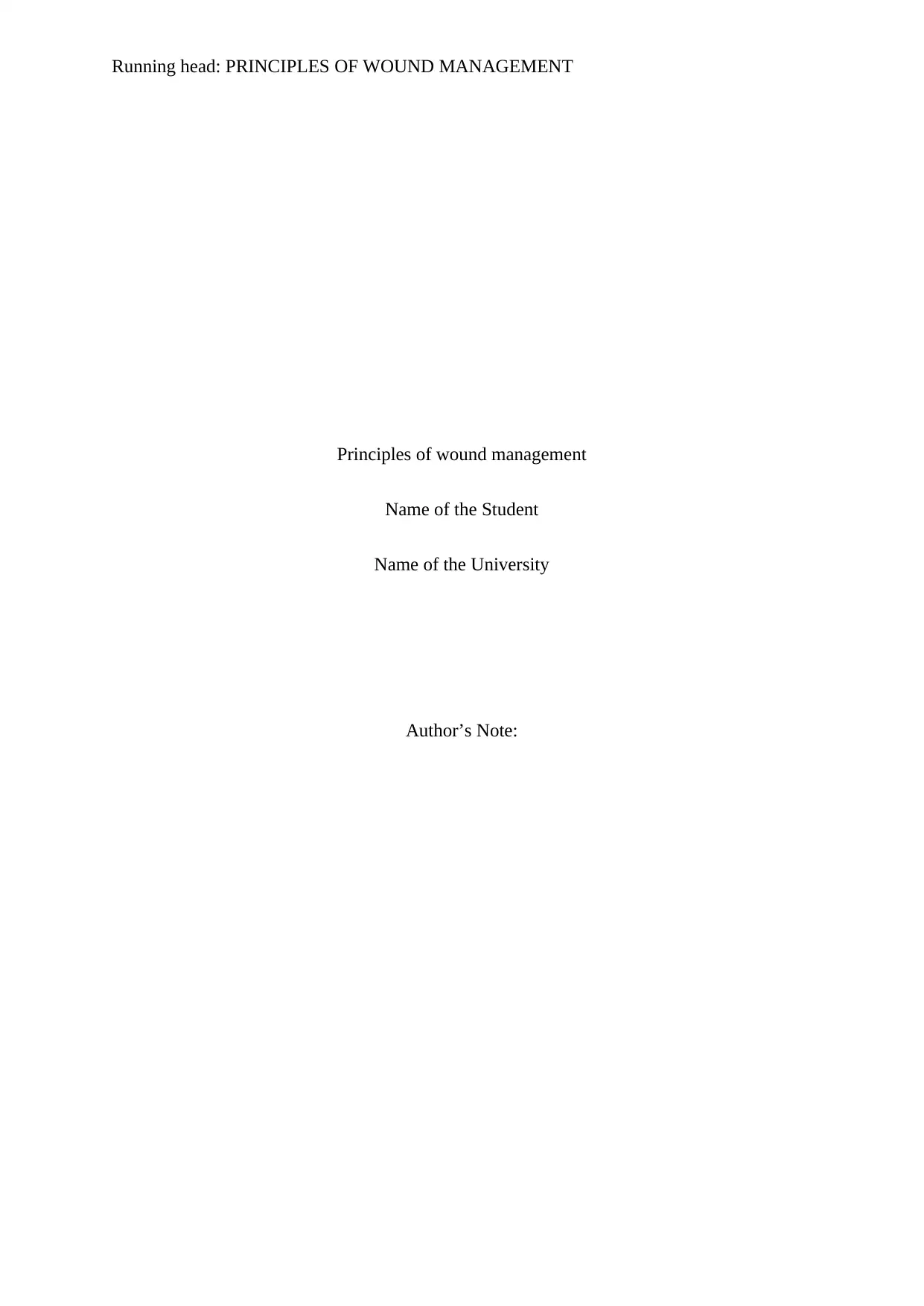
Running head: PRINCIPLES OF WOUND MANAGEMENT
Principles of wound management
Name of the Student
Name of the University
Author’s Note:
Principles of wound management
Name of the Student
Name of the University
Author’s Note:
Paraphrase This Document
Need a fresh take? Get an instant paraphrase of this document with our AI Paraphraser
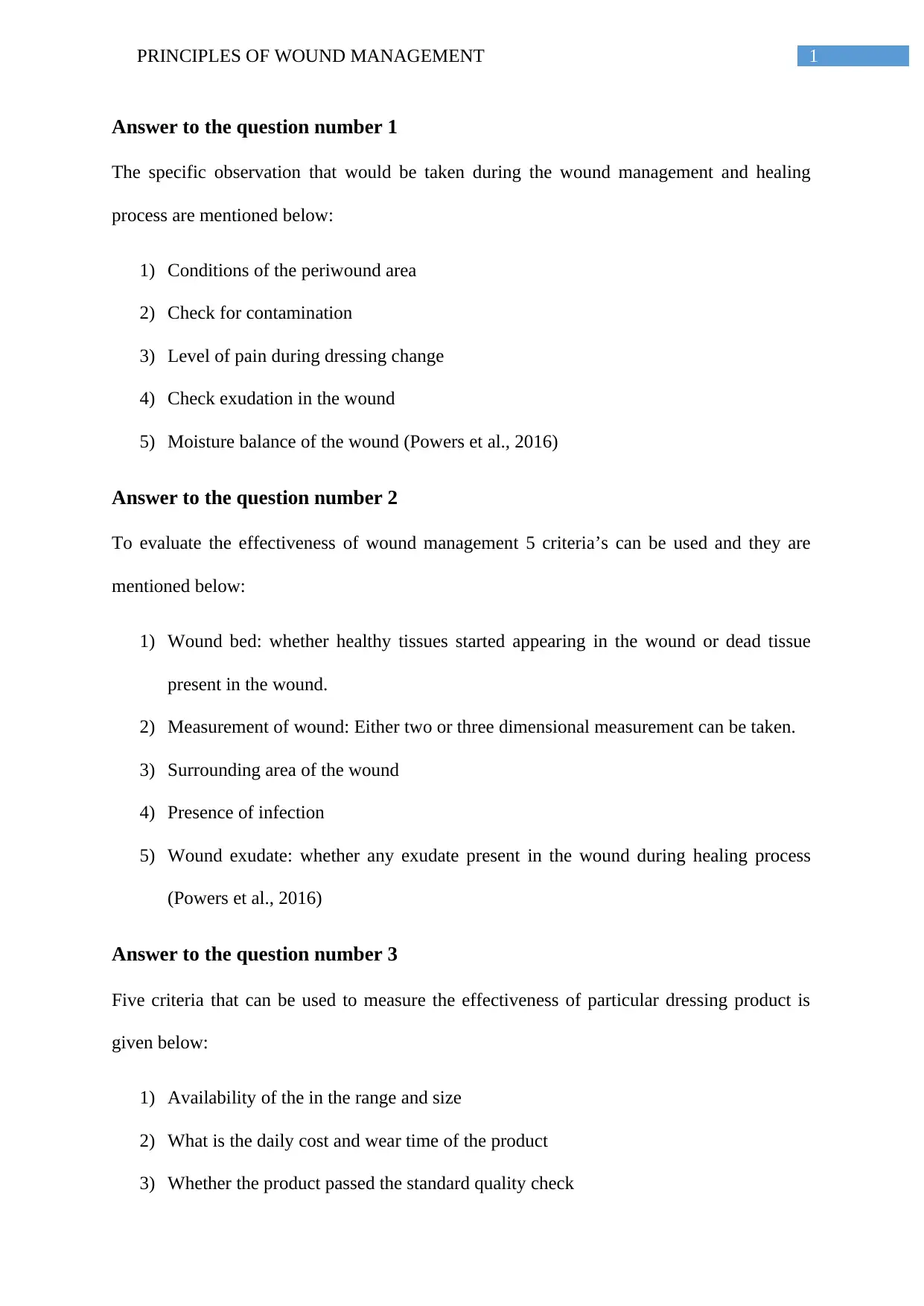
1PRINCIPLES OF WOUND MANAGEMENT
Answer to the question number 1
The specific observation that would be taken during the wound management and healing
process are mentioned below:
1) Conditions of the periwound area
2) Check for contamination
3) Level of pain during dressing change
4) Check exudation in the wound
5) Moisture balance of the wound (Powers et al., 2016)
Answer to the question number 2
To evaluate the effectiveness of wound management 5 criteria’s can be used and they are
mentioned below:
1) Wound bed: whether healthy tissues started appearing in the wound or dead tissue
present in the wound.
2) Measurement of wound: Either two or three dimensional measurement can be taken.
3) Surrounding area of the wound
4) Presence of infection
5) Wound exudate: whether any exudate present in the wound during healing process
(Powers et al., 2016)
Answer to the question number 3
Five criteria that can be used to measure the effectiveness of particular dressing product is
given below:
1) Availability of the in the range and size
2) What is the daily cost and wear time of the product
3) Whether the product passed the standard quality check
Answer to the question number 1
The specific observation that would be taken during the wound management and healing
process are mentioned below:
1) Conditions of the periwound area
2) Check for contamination
3) Level of pain during dressing change
4) Check exudation in the wound
5) Moisture balance of the wound (Powers et al., 2016)
Answer to the question number 2
To evaluate the effectiveness of wound management 5 criteria’s can be used and they are
mentioned below:
1) Wound bed: whether healthy tissues started appearing in the wound or dead tissue
present in the wound.
2) Measurement of wound: Either two or three dimensional measurement can be taken.
3) Surrounding area of the wound
4) Presence of infection
5) Wound exudate: whether any exudate present in the wound during healing process
(Powers et al., 2016)
Answer to the question number 3
Five criteria that can be used to measure the effectiveness of particular dressing product is
given below:
1) Availability of the in the range and size
2) What is the daily cost and wear time of the product
3) Whether the product passed the standard quality check
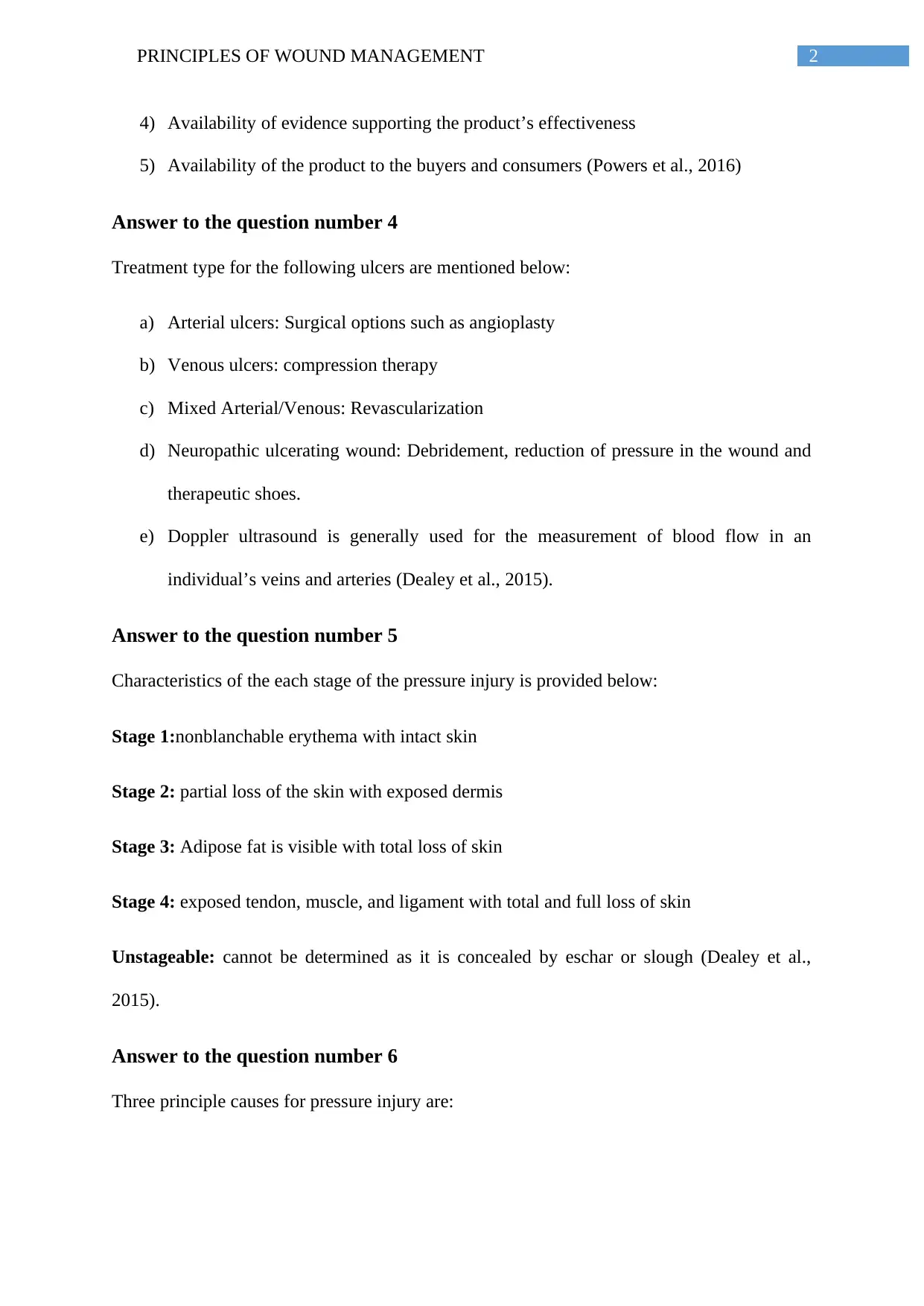
2PRINCIPLES OF WOUND MANAGEMENT
4) Availability of evidence supporting the product’s effectiveness
5) Availability of the product to the buyers and consumers (Powers et al., 2016)
Answer to the question number 4
Treatment type for the following ulcers are mentioned below:
a) Arterial ulcers: Surgical options such as angioplasty
b) Venous ulcers: compression therapy
c) Mixed Arterial/Venous: Revascularization
d) Neuropathic ulcerating wound: Debridement, reduction of pressure in the wound and
therapeutic shoes.
e) Doppler ultrasound is generally used for the measurement of blood flow in an
individual’s veins and arteries (Dealey et al., 2015).
Answer to the question number 5
Characteristics of the each stage of the pressure injury is provided below:
Stage 1:nonblanchable erythema with intact skin
Stage 2: partial loss of the skin with exposed dermis
Stage 3: Adipose fat is visible with total loss of skin
Stage 4: exposed tendon, muscle, and ligament with total and full loss of skin
Unstageable: cannot be determined as it is concealed by eschar or slough (Dealey et al.,
2015).
Answer to the question number 6
Three principle causes for pressure injury are:
4) Availability of evidence supporting the product’s effectiveness
5) Availability of the product to the buyers and consumers (Powers et al., 2016)
Answer to the question number 4
Treatment type for the following ulcers are mentioned below:
a) Arterial ulcers: Surgical options such as angioplasty
b) Venous ulcers: compression therapy
c) Mixed Arterial/Venous: Revascularization
d) Neuropathic ulcerating wound: Debridement, reduction of pressure in the wound and
therapeutic shoes.
e) Doppler ultrasound is generally used for the measurement of blood flow in an
individual’s veins and arteries (Dealey et al., 2015).
Answer to the question number 5
Characteristics of the each stage of the pressure injury is provided below:
Stage 1:nonblanchable erythema with intact skin
Stage 2: partial loss of the skin with exposed dermis
Stage 3: Adipose fat is visible with total loss of skin
Stage 4: exposed tendon, muscle, and ligament with total and full loss of skin
Unstageable: cannot be determined as it is concealed by eschar or slough (Dealey et al.,
2015).
Answer to the question number 6
Three principle causes for pressure injury are:
⊘ This is a preview!⊘
Do you want full access?
Subscribe today to unlock all pages.

Trusted by 1+ million students worldwide
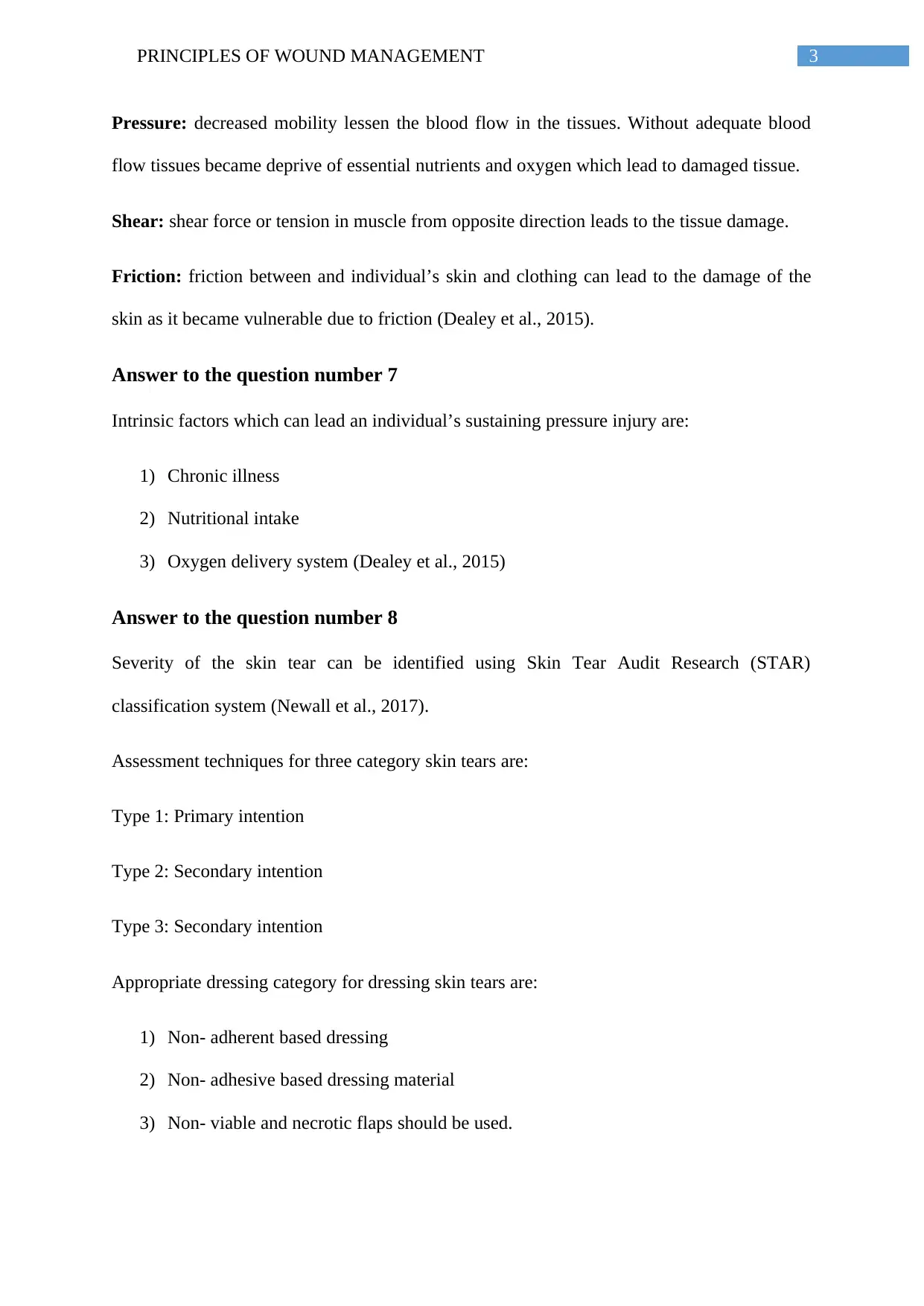
3PRINCIPLES OF WOUND MANAGEMENT
Pressure: decreased mobility lessen the blood flow in the tissues. Without adequate blood
flow tissues became deprive of essential nutrients and oxygen which lead to damaged tissue.
Shear: shear force or tension in muscle from opposite direction leads to the tissue damage.
Friction: friction between and individual’s skin and clothing can lead to the damage of the
skin as it became vulnerable due to friction (Dealey et al., 2015).
Answer to the question number 7
Intrinsic factors which can lead an individual’s sustaining pressure injury are:
1) Chronic illness
2) Nutritional intake
3) Oxygen delivery system (Dealey et al., 2015)
Answer to the question number 8
Severity of the skin tear can be identified using Skin Tear Audit Research (STAR)
classification system (Newall et al., 2017).
Assessment techniques for three category skin tears are:
Type 1: Primary intention
Type 2: Secondary intention
Type 3: Secondary intention
Appropriate dressing category for dressing skin tears are:
1) Non- adherent based dressing
2) Non- adhesive based dressing material
3) Non- viable and necrotic flaps should be used.
Pressure: decreased mobility lessen the blood flow in the tissues. Without adequate blood
flow tissues became deprive of essential nutrients and oxygen which lead to damaged tissue.
Shear: shear force or tension in muscle from opposite direction leads to the tissue damage.
Friction: friction between and individual’s skin and clothing can lead to the damage of the
skin as it became vulnerable due to friction (Dealey et al., 2015).
Answer to the question number 7
Intrinsic factors which can lead an individual’s sustaining pressure injury are:
1) Chronic illness
2) Nutritional intake
3) Oxygen delivery system (Dealey et al., 2015)
Answer to the question number 8
Severity of the skin tear can be identified using Skin Tear Audit Research (STAR)
classification system (Newall et al., 2017).
Assessment techniques for three category skin tears are:
Type 1: Primary intention
Type 2: Secondary intention
Type 3: Secondary intention
Appropriate dressing category for dressing skin tears are:
1) Non- adherent based dressing
2) Non- adhesive based dressing material
3) Non- viable and necrotic flaps should be used.
Paraphrase This Document
Need a fresh take? Get an instant paraphrase of this document with our AI Paraphraser
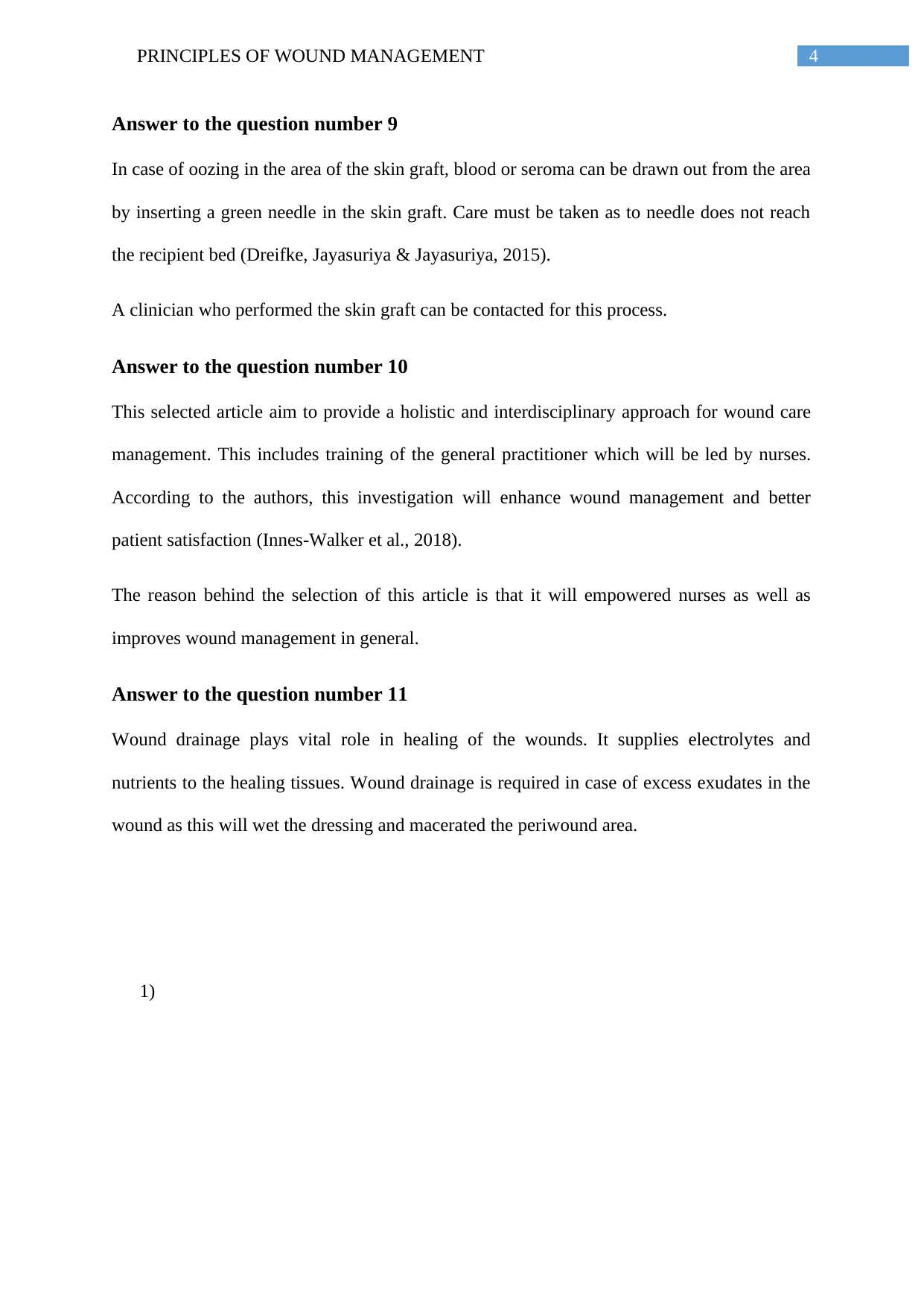
4PRINCIPLES OF WOUND MANAGEMENT
Answer to the question number 9
In case of oozing in the area of the skin graft, blood or seroma can be drawn out from the area
by inserting a green needle in the skin graft. Care must be taken as to needle does not reach
the recipient bed (Dreifke, Jayasuriya & Jayasuriya, 2015).
A clinician who performed the skin graft can be contacted for this process.
Answer to the question number 10
This selected article aim to provide a holistic and interdisciplinary approach for wound care
management. This includes training of the general practitioner which will be led by nurses.
According to the authors, this investigation will enhance wound management and better
patient satisfaction (Innes-Walker et al., 2018).
The reason behind the selection of this article is that it will empowered nurses as well as
improves wound management in general.
Answer to the question number 11
Wound drainage plays vital role in healing of the wounds. It supplies electrolytes and
nutrients to the healing tissues. Wound drainage is required in case of excess exudates in the
wound as this will wet the dressing and macerated the periwound area.
1)
Answer to the question number 9
In case of oozing in the area of the skin graft, blood or seroma can be drawn out from the area
by inserting a green needle in the skin graft. Care must be taken as to needle does not reach
the recipient bed (Dreifke, Jayasuriya & Jayasuriya, 2015).
A clinician who performed the skin graft can be contacted for this process.
Answer to the question number 10
This selected article aim to provide a holistic and interdisciplinary approach for wound care
management. This includes training of the general practitioner which will be led by nurses.
According to the authors, this investigation will enhance wound management and better
patient satisfaction (Innes-Walker et al., 2018).
The reason behind the selection of this article is that it will empowered nurses as well as
improves wound management in general.
Answer to the question number 11
Wound drainage plays vital role in healing of the wounds. It supplies electrolytes and
nutrients to the healing tissues. Wound drainage is required in case of excess exudates in the
wound as this will wet the dressing and macerated the periwound area.
1)
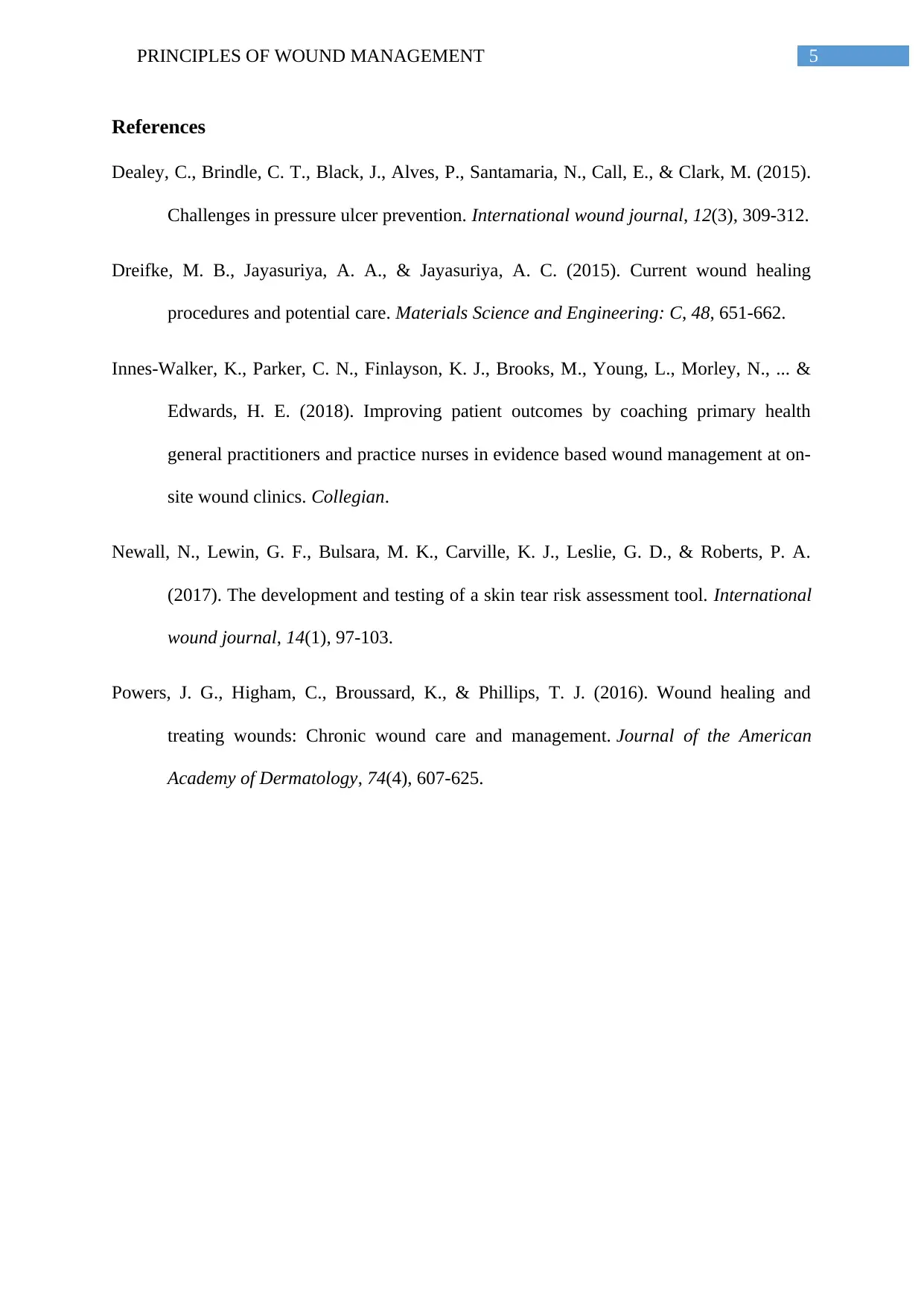
5PRINCIPLES OF WOUND MANAGEMENT
References
Dealey, C., Brindle, C. T., Black, J., Alves, P., Santamaria, N., Call, E., & Clark, M. (2015).
Challenges in pressure ulcer prevention. International wound journal, 12(3), 309-312.
Dreifke, M. B., Jayasuriya, A. A., & Jayasuriya, A. C. (2015). Current wound healing
procedures and potential care. Materials Science and Engineering: C, 48, 651-662.
Innes-Walker, K., Parker, C. N., Finlayson, K. J., Brooks, M., Young, L., Morley, N., ... &
Edwards, H. E. (2018). Improving patient outcomes by coaching primary health
general practitioners and practice nurses in evidence based wound management at on-
site wound clinics. Collegian.
Newall, N., Lewin, G. F., Bulsara, M. K., Carville, K. J., Leslie, G. D., & Roberts, P. A.
(2017). The development and testing of a skin tear risk assessment tool. International
wound journal, 14(1), 97-103.
Powers, J. G., Higham, C., Broussard, K., & Phillips, T. J. (2016). Wound healing and
treating wounds: Chronic wound care and management. Journal of the American
Academy of Dermatology, 74(4), 607-625.
References
Dealey, C., Brindle, C. T., Black, J., Alves, P., Santamaria, N., Call, E., & Clark, M. (2015).
Challenges in pressure ulcer prevention. International wound journal, 12(3), 309-312.
Dreifke, M. B., Jayasuriya, A. A., & Jayasuriya, A. C. (2015). Current wound healing
procedures and potential care. Materials Science and Engineering: C, 48, 651-662.
Innes-Walker, K., Parker, C. N., Finlayson, K. J., Brooks, M., Young, L., Morley, N., ... &
Edwards, H. E. (2018). Improving patient outcomes by coaching primary health
general practitioners and practice nurses in evidence based wound management at on-
site wound clinics. Collegian.
Newall, N., Lewin, G. F., Bulsara, M. K., Carville, K. J., Leslie, G. D., & Roberts, P. A.
(2017). The development and testing of a skin tear risk assessment tool. International
wound journal, 14(1), 97-103.
Powers, J. G., Higham, C., Broussard, K., & Phillips, T. J. (2016). Wound healing and
treating wounds: Chronic wound care and management. Journal of the American
Academy of Dermatology, 74(4), 607-625.
⊘ This is a preview!⊘
Do you want full access?
Subscribe today to unlock all pages.

Trusted by 1+ million students worldwide
1 out of 6
Related Documents
Your All-in-One AI-Powered Toolkit for Academic Success.
+13062052269
info@desklib.com
Available 24*7 on WhatsApp / Email
![[object Object]](/_next/static/media/star-bottom.7253800d.svg)
Unlock your academic potential
Copyright © 2020–2025 A2Z Services. All Rights Reserved. Developed and managed by ZUCOL.





